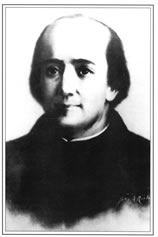The most popular story about Father Jacques Marquette is that he
discovered the Mississippi River. Paintings and monuments reinforce
the myth of the Jesuit scholar traveling into unknown territory and
discovering North America's greatest river for European civilization.
Did Marquette discover the Mississippi River? Certainly, the Indians
knew of the river. It is possible that major sections of the Mississippi
were found independently by various European explorers during the
same time period. Marquette's journal indicates that Spain already
had a settlement at the mouth of the Mississippi. Marquette may not
have discovered the great river, but his journey proved the existence
of water routes to the fabled Mississippi.
Another popular Marquette legend is that the missionary spoke six
Indian languages. In his journal Marquette stated, "At first,
we had to speak by signs, because none of [the Indians] understood
the six languages which I spoke." Marquette biographer Father
Claude Dablon compared Marquette to St. Francis Xavier, noting, "He
resembled that great saint... in the variety of barbarian languages
which he mastered."
The Algonquin and the Iroquois languages are as dissimilar as Russian
and English. Mastering six Indian languages would have been possible,
but difficult. It is more likely that Marquette and Dablon were
referring to Indian dialects. Jesuit records of the period state
that "Marquette was supposed to learn some of the Algonquin
dialects before everything else." This indicates that his prowess
in native dialect was considered sufficient for him to begin active
missionary life among the Algonquin tribes dwelling around Lake Superior.
According to one twentieth century Jesuit scholar, "the North
American Jesuits had made up their minds that the only way to convert
the Indians was through the medium of their own language."
Accounts of Marquette's mastery of several Indian languages are
still found in books today. But even if Marquette did not know
six Indian
languages, his knowledge of their dialects was superior to that
of many missionaries and traders, and as a translator he was
an asset
to any wilderness journey.
Adding to the Marquette mystique is the fact that no one knows
what he really looked like. No drawing, sketch or painting remains
from
the period in which he lived. The imagination and skill of painters
and sculptors all reflecting the attitudes of their respective
times provide the only references to his physical stature and
facial expressions.
How Marquette achieved this legendary status as an explorer and
missionary is a lesson in historical documentation. The real
explorers and discoverers
of the French colonial era--the voyageurs, the coureurs de
bois and the Indians--left few written records. The Jesuit missionaries,
on
the other hand, kept detailed journals. In New France these
journals were sent to Quebec each autumn to be edited and published
in
annual reports chronicling the relations of the Jesuit missionaries
and
the Indians of North America.
Between 1611 and 1673 the Jesuit Relations were published
in France by Sebastien Cramoisy. The Relations were both a narrative
and
a fundraising document. They were popular reading throughout
France--especially in the courts of Paris among wealthy sympathizers
to the Jesuit
cause
in New France. The Relations dropped into obscurity
as the Jesuits fell out of political power. In 1858 the Canadian
government reissued the Cramoisy series of the Relations and
included
Marquette's
journal
and the two additional sections in this book. Marquette's
journal, like the entire Relations, offers a unique
view of the discoveries,
explorations and conditions in North America during the seventeenth
century.
Finally, it is easy to attribute legendary characteristics
to the men of that era. There is a romance that stirs
the imagination.
The thought of 12 voyageurs, paddling 35 foot long canoes
loaded with thousands of pounds of furs through uncharted waterways
and facing exciting
new challenges around every bend, gives a larger than life quality
to this chapter in the history of the region.
|


